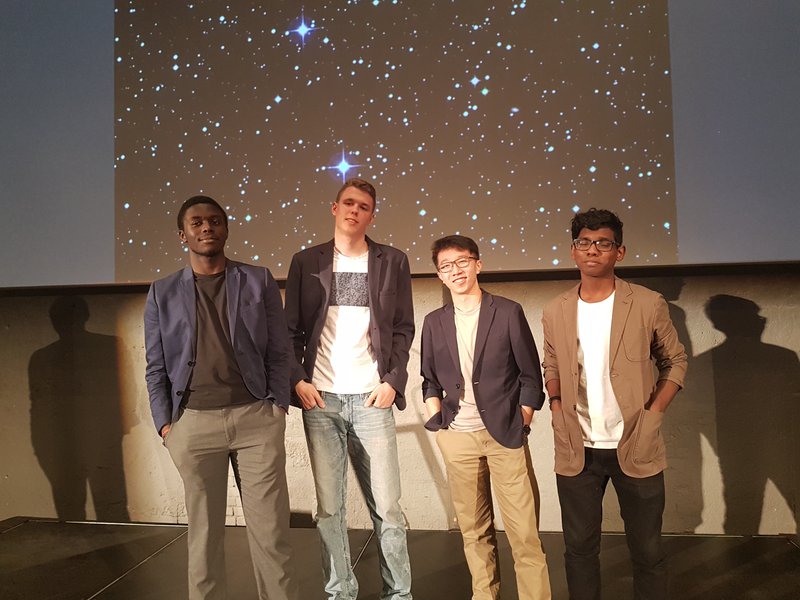Four Shades of Brown | Live Smart
Awards & Nominations
Four Shades of Brown has received the following awards and nominations. Way to go!
The Challenge | Live Smart
CO2 Sweep
By relaying atmospheric satellite data to drones equipped with materials acting as carbon dioxide vacuums, we've designed the stepping stone to a cleaner, sustainable atmosphere.

Hello world!
We, Four Shades of Brown, are a team of four highschool students from Martingrove CI. We headed into this hackathon with open minds and only the expectations to learn something new. However, the concept of CO2 Sweep inspired us and and excited those around us. We're now very passionate about our project and its applications for a smarter, sustainable future.
Overview
SkyTree is a system for smart living that incorporates three major components. Firstly, satellite data on CO2 concentrations are called from SkyWatch API. Data is then filtered and coordinates sent to drones carrying polyethylenimine (PEI). The aim of SkyTree is to reduce the average CO2 concentrations autonomously from 400ppm to a stable and healthy level of 350ppm, an essential function of the cities of our future - smart cities.
Implications
As we move towards a new era of smart cities, we need to consider the state of the air we breathe. We're currently on route to 450 ppm of CO2 by the year 2025. It is at this point where you can flip a coin to decide whether or not our atmosphere will ever return to stability. A smart world would not face this issue, rather they would synergize the technologies and informations at their disposal to monitor their waste release.
Imagine a world where the health of our own race and coexisting species alike is not an impending issue. Looking up, you see specks dotting the horizon, buzzing and swirling like a group of bumblebees. You take in a breath of fresh air and exhale - without having to think about how almost all our human activities expel CO2.
How it works
Satellite data
When it comes to satellite data, there are many options for satellites that provide CO2 concentrations. We've experimented and prototyped with AIRS data but plan on moving to SAR once it becomes available. We filter coordinates down to locations with concentrations at and above 400 ppm. The autonomous nature between drones and satellite data allow us to truly assimilate a smart approach to data collection and manage the environment around us.
Drone power
The mobility and strength of drones make them a perfect suitor for our needs. However, we've got a few innovations in store in order to allow CO2 Sweep to be as efficient as possible. Referencing the groundbreaking advancements made by Alta Devices in solar cells, we plan on powering the quadcopters primarily by solar energy. This helps to minimize our system's footprint as well as increase flight times. Alternative mechanisms of delivery include "gliding" drones and blimps as we move to an increasingly comprehensive solution.
CO2 Absorbant
Polyethylenimine (PEI), is a polymer with the highest known CO2 absorption rates known to mankind. With 7.3 wt% a drone carrying 2kg would be capable of converting and carrying 146.8g of CO2. The polymer converts converts carbon dioxide into the harmless carbamate. Carbamate is stored within the PEI until heated to 100 degrees Celsius at which the CO2 can be re-released, a property that can have secondary applications.
Resources
- http://www.altadevices.com/technology/
- http://www4.ncsu.edu/~hubbe/PEI.htm
- http://www.skywatch.co/datasets
- http://www.sciencedirect.com/science/article/pii/S0009250914002280
- https://www.acs.org/content/acs/en/pressroom/press...
- https://www.epa.gov/ghgemissions/overview-greenhou...
Acknowledgements
- We'd like to extend a huge thank you first and foremost to James Silfierz and his team at SkyWatch for their assistance throughout the hackathon and continually through our development phase
- Thanks to Apoorv Sinha, CEO @Carbon Upcycling Technologies for his time and input
- Huge shoutout to Abeer and Kaz from Deloitte Consulting for their technical assistance and encouragement
- We couldn't have done it without Michelle Mendes and the rest of the board from the CSCA for exposing problems we had previously overlooked
- Martingrove CI has been a rock solid base for our aspirations, we'd like to acknowledge our principle Mr. Palermo and a dedicated team teachers that helped us in every way possible
- Last but not least, we are grateful for the undying love and support from our family and friends
SpaceApps is a NASA incubator innovation program.